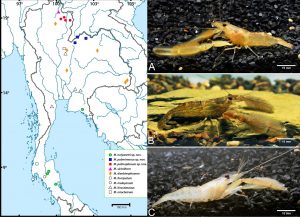Highlight Activities 2020: Molecular phylogeny and species delimitation of the freshwater prawn Macrobrachium pilimanus species group, with descriptions of three new species from Thailand
Molecular phylogeny and species delimitation of the freshwater prawn Macrobrachium pilimanus species group, with descriptions of three new species from Thailand
Lect. Warut Siriwut and Asist. Prof. Ekgachai Jeratthitikul
ABSTRACT
Specific status and species boundaries of several freshwater prawns in the Macrobrachium pilimanus species group remain ambiguous, despite the taxonomic redescription of type materials and additional specimens collected to expand the boundaries of some species. In this study, the “pilimanus” species group of Macrobrachium sensu Johnson (1958) was studied using specimens collected from montane streams of Thailand. Molecular phylogenetic analyses based on sequences of three molecular markers (COI, 16S and 18S rRNA) were performed. The phylogenetic results agreed with morphological identifications, and indicated the presence of at least nine putative taxa. Of these, six morphospecies were recognised as M. malayanum, M. forcipatum, M. dienbienphuense, M. hirsutimanus, M. eriocheirum, and M. sirindhorn. Furthermore, three morphologically and genetically distinct linages were detected, and are described herein as M. naiyanetri Siriwut sp. nov., M. palmopilosum Siriwut sp. nov. and M. puberimanus Siriwut sp. nov. The taxonomic comparison indicated wide morphological variation in several species and suggested additional diagnostic characters that are suitable for use in species diagnoses, such as the shape and orientation of fingers, the rostrum form, and the presence or absence of velvet pubescence hairs and tuberculated spinulation on each telopodite of the second pereiopods. The “pilimanus” species group was portrayed as non-monophyletic in both ML and BI analyses. The genetic structure of different geographical populations in Thailand was detected in some widespread species. The species delimitation based on the four delimitation methods (BIN, ABGD, PTP and GMYC) suggested high genetic diversity of the “pilimanus” species group and placed the candidate members much higher than in previous designations based on traditional morphology. This finding suggests that further investigation of morphological and genetic diversity of Southeast Asian freshwater prawns in the genus Macrobrachium is still required to provide a comprehensive species list to guide efforts in conservation and resource management.
Reference
Siriwut W, Jeratthitikul E, Panha S, Chanabun R, Sutcharit C. 2020. Molecular phylogeny and species delimitation of the freshwater prawn Macrobrachium pilimanus species group, with descriptions of three new species from Thailand. PeerJ 8:e10137 https://doi.org/10.7717/peerj.10137


